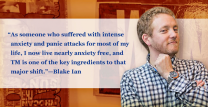Chuck Otto of Chicago is a writer/editor and PR professional specializing in corporate social responsibility and sustainable business practices. He is also a Transcendental Meditation practitioner of just over one year, and recently shared his meditation experiences in a blog post on NextAvenue.org. Read the excerpts below to find out why he decided to learn, and why he expects to keep meditating for the rest of his life.
Several years into adult life, I spent some time exploring different religions. I particularly liked the Baha’i faith, which emphasizes “the spiritual unity of all mankind.” Baha’i views all religious figures, from Moses and Muhammad to Buddha and Jesus, as “messengers” heralding our evolution to eventual world peace. I loved the conceptual framework, but certain fasting and abstinence requirements sent me packing. Ultimately, I claimed Nature as my true religion, forest and shore as my sacred ground (something I still believe), while joking of my devotion to “the tree people.”
Flash forward a few decades and suddenly there I was, coping with divorce, death and life’s other defining moments as I confronted my own fleeting mortality. Where were those tree people now that I needed them?
A few years ago I realized that my lack of a spiritual life knocked everything else off-kilter. I also recognized that I needed a way to unplug from the stresses of everyday life or run the risk of slipping into serious substance abuse, antisocial behavior, and/or a hermit’s existence.
Transcendental Meditation provided me with part of the solution. Not as a religious practice, because TM is a tool, not an ideology. Rather, it offered me a way to take myself offline for a few minutes each day to recharge, refresh and just exist in the present moment.
The journey began when I attended an informational TM talk at my local library and connected with Carol and Paul Morehead, two longtime TM teacher/practitioners based in Evanston, Ill. Once I signed on, they gave me my mantra — the sound-with-no-meaning that one repeats, silently during a 20-minute meditation session. Through periodic check-ins and TM group gatherings, Carol and Paul have kept me on track with my practice.
For those whose knowledge of Transcendental Meditation begins and ends with old 1960s pictures of the Beatles and the Maharishi looking blissed-out, the decades since have amassed a considerable body of clinical research affirming its value. TM has earned solid props for dealing with depression, ADHD, PTSD and many other modern toxic stresses. Soldiers, students, business leaders, prisoners, prison guards and numerous celebrity types swear by it. Speaking from a one-year practitioner’s perspective, TM’s benefits include a better night’s sleep and the ability to let go of negative thoughts and feelings more quickly.
So, what’s it like to meditate? Speaking personally, it’s a calming, welcome break I look forward to ideally twice a day, but one that requires a constant, gentle nudging away from intruding thoughts.
I imagine that each person’s meditation experience is different. Some TM practitioners speak of extended periods of transcendence, where space and time are meaningless and their creativity is super-charged. So far I have had only a few, fleeting moments that approached this state. But I see other benefits. Nighttime rest comes more easily for me now, and the mental rehashing of unpleasant experiences passes more quickly. These gifts alone likely will keep me meditating for the rest of my life.
(This article was published in original format on and by NextAvenue).




